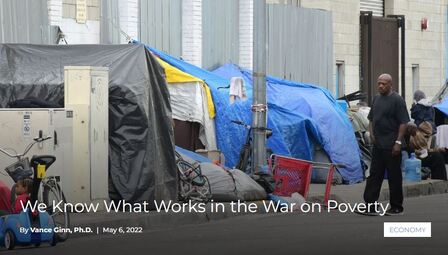 Did you know there’s a state park in Arkansas where you can search for diamonds—real diamonds? And you get to keep what you find. In April, Adam Hardin was visiting Crater of Diamonds State Park and came across a 2.38 carat stone—the largest found so far this year. Diamonds can be found in the 37-acre plowed field, but naturally, they’re rare. It’s a little like the successes that can be seen in our nearly 60-year-old War on Poverty: valuable, but rare. Nationally, about $25 trillion (adjusted for inflation) have been spent to combat poverty since 1964 when President Lyndon B. Johnson’s War on Poverty engendered the Great Society. However, the country’s poverty rate was declining before 1964 but remained virtually unchanged since then, suggesting a failure of these redistributionist measures. But over the years, we’ve learned much. And we know what works in combatting poverty. We also know which key institutions and factors contribute to keeping people in poverty. With good policy—and clearer objectives—we can reverse this trend and truly lift people out of debilitating circumstances that lead to generational poverty. But first, a little history. The 1920–21 recession was the last major economic downturn in American history that was not met with federal intervention designed to stabilize the economy and mitigate poverty. A decade later, Presidents Herbert Hoover and Franklin Delano Roosevelt presided over the first large-scale and nationwide anti-poverty measures during the 1930s and the Great Depression. Despite these large-scale interventions, the unemployment rate remained in double digits for the remainder of the 1930s. More people were dependent on new government programs, and the costly economic effects of these and other government actions reduced both productivity and job creation. A quarter century later, President Lyndon B. Johnson advocated his War on Poverty as part of domestic policy initiatives commonly called the Great Society. But again, poverty relief programs did not substantially accelerate the poverty rate’s reduction—in fact, the rate of decline slowed before essentially stalling. Why? Because these efforts failed to address the real drivers of poverty—in many instances, they became drivers of poverty themselves. There are several factors that are strongly linked with continued poverty and an inability to build income and wealth. The most powerful predictor of poverty in general is single motherhood. Another factor is where you live (including all 41 Texas counties within 100 miles of the U.S.-Mexican border, considered “persistently poor”). And age is also a factor in poverty, but its impact varies depending on other group characteristics. Metro areas with a younger Black population have higher poverty rates, while areas with an older Black population have lower poverty rates. But possibly the most pertinent factor in keeping people trapped in poverty is an incentive not to work or to be more productive. For example, a “benefits cliff” occurs when a safety-net recipient goes back to work, increases their workload, or accepts a higher rate of pay, resulting in increased total earned income—which then triggers a greater loss of payments from government programs. What works? Work. Employment, in general, drives down poverty. By connecting people to work, education, or training, enhancing community-based case management, streamlining safety-net programs, and getting resources to those who need it most, we can create more opportunities for people to be self-sufficient—and thereby reduce the number of Americans experiencing poverty—so long as we have the will, perseverance, and right approach. Finding diamonds in a field of dirt isn’t easy; nor is providing people with a real path out of poverty. But with diligence, and a keen eye, we can see more and more success. https://www.texaspolicy.com/we-know-what-works-in-the-war-on-poverty/ Comments are closed.
|
Vance Ginn, Ph.D.
|

 RSS Feed
RSS Feed